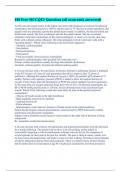Exam (elaborations)
100 Free MCCQE1 Questions (all accurately answered)
- Course
- Institution
An 80-year-old woman comes to the urgent care clinic with dyspnoea on exertion. On physical examination, her blood pressure is 100/70, and her pulse is 75. She has no pulsus paradoxus. Her jugular veins are distended, and she has distant heart sounds. In addition, she has extra third and fourth hea...
[Show more]



